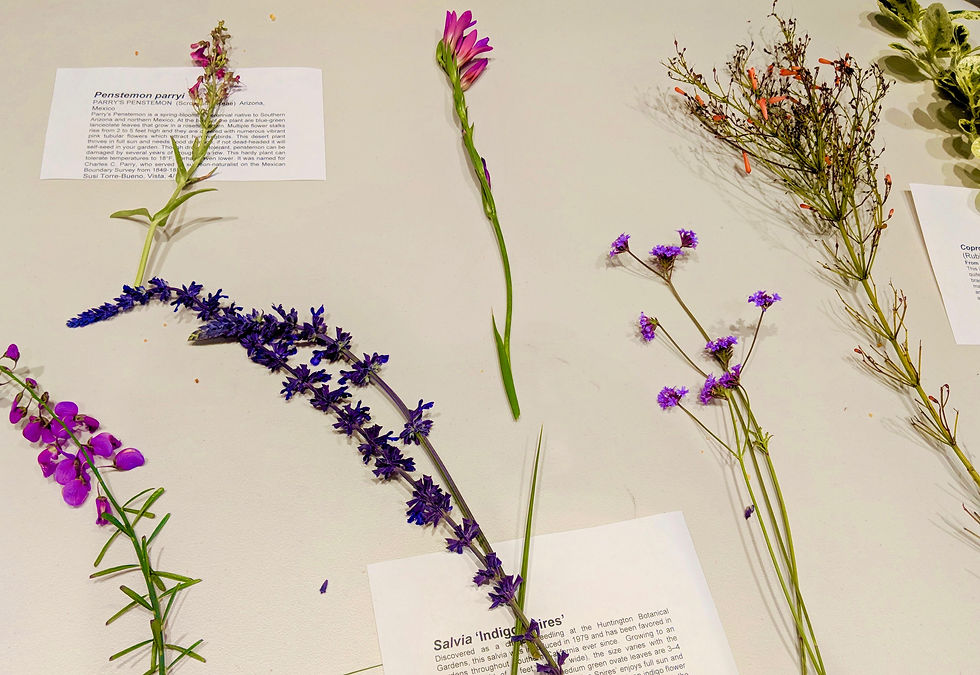MEETING REPORT: Insurance for Native Plants
- Rachel Cobb

- Apr 30, 2018
- 3 min read
By Jeannine Romero.
You may be surprised to learn that the San Diego Zoo has a botanical population that is worth more than the animal population. The organization is committed to conservation efforts not only related to animals threatened with extinction, but it has a full-fledged mission to save native plants threatened by extinction as well.

Stacy Anderson and Joe Davitt, two of the researchers carrying out the Plant Conservation team's mission for San Diego Zoo Global (which includes the San Diego Safari Park and the Institute for Conservation Research), met with SDHS members at the April monthly meeting to share information about their work.
Plants, because they make oxygen, are critical to the success of the planet, but they can become extinct due to habitat loss as a consequence of development, invasive species encroachment, or frequent fires, Anderson noted. So, native plant seeds have been collected by the tens of thousands throughout San Diego county to conserve the diversity of native plants and save them from extinction.
Anderson said that San Diego Zoo Global fights against extinction worldwide, “but we know the importance of working in our own backyard.” Lake Hodges has been the site of one of their team's local habitat restoration projects, she added. The endangered Tecate cypress, once headed towards extinction following the 2003 and 2007 San Diego fires, is another local treasure whose seeds are banked.
As part of their work, Anderson and Davitt participate in the California Plant Rescue (CaPR) program to maintain botanic diversity with a seed bank, prioritize rare plants, and monitor rare plant populations. Anderson went on to explain the history and the importance of seed banks.
Seed banks started in the 1930s when Russian botanist Nikolai Ivanovich Vavilov developed the idea of collecting seeds. Today, there are seed banks worldwide; the largest of these are the Millennium Seed Bank at the Royal Botanic Gardens, Kew (with one billion seeds banked), the USDA's National Laboratory for Genetic Resource Preservation, and the Svalbard Global Seed Vault in Norway.
Seed banking is easy insurance against catastrophic loss, conserves genetic diversity, and provides material for research. Researchers take care to sample the population of a species by taking seeds randomly to conserve all genetic information. And with proper storage of seeds, their future potential may outlive us all: the oldest known seed that made a viable plant is the Silene Stenophylla, when frozen samples were discovered and a group of scientists successfully grew a plant from seeds estimated to be 32,000 years old.
Joe Davitt, another researcher at the Institute, described collecting strategies and noted that they collect as many as 2,500 seeds for conservation purposes and they have a goal of 10,000 for restoration purposes. He said the work can get tedious for long-term storage with counting, performing viability, and in-season germination tests. Finally, seeds are hermetically sealed in foil-lined envelopes and stored at zero degrees Fahrenheit.
But what can you do to assist in plant conservation efforts? Davitt suggests that homeowners can remove weeds, not grow invasive plants (in order to avoid encroachment problems), and purchase plants from a nursery where plants are propagated to ensure that they are not illegally removed from the wild. He added that citizens are encouraged to make home gardens a refuge for native wildflowers and wildlife, and to volunteer to assist in botanical gardens.
From Our Gardens

Many thanks to Susi Torre-Bueno for bringing an array of garden samples to our April meeting, along with detailed plant descriptions for each. We could easily imagine the painterly swaths of color that must be filling her garden this spring!
